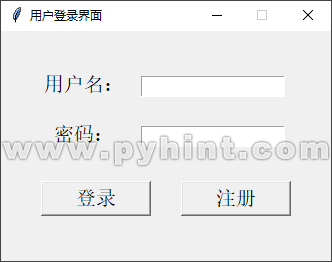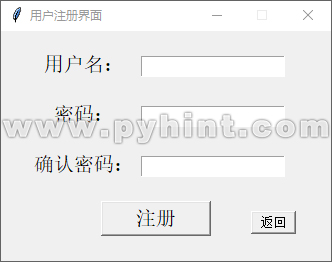在Python中,Tkinter库是最常用于构建GUI应用程序的标准GUI库。Tkinter库使用起来比较简单,容易上手。在本节教程中,我们将使用Tkinter库结合SQLite数据库来创建登录和注册界面。SQLite数据库是Python中一个轻量级的嵌入式关系型数据库管理系统,不需要单独的服务器进程,数据库直接存储在单一文件中,无需安装和配置,在Python中可以直接使用。
1、利用Tkinter和SQLite制作用户登录和注册界面程序介绍
我们的目标是开发一个登录和注册界面程序,使用Tkinter库来设计登录和注册界面布局,并结合SQLite数据库来存储用户信息。该程序运行后,会在当前工作目录下创建一个名为“login.db”数据库文件,并在数据库中创建一个user数据库表,用于保存用户名和密码。user数据库表中包含两个字段:“username”(用户名,不可为空)、“password”(密码,不可为空)。
在登录界面中,用户可以尝试登录,如果出现三次失败,则会自动终止程序。在注册界面中,允许用户输入新的账号和密码,如果注册信息验证成功,信息将会被保存到“login.db”数据库文件中。
2、利用Tkinter和SQLite制作用户登录和注册界面程序演示


3、代码实现
(1)导入必要的库
import tkinter as tk
from tkinter import messagebox
import os, sys, sqlite3
这里导入了tkinter库用于创建GUI应用图形界面,tkinter的messagebox用于消息提示。os库用于文件和文件夹操作。sys库可以与Python解释器及其运行环境进行交互。sqlite3库用于连接SQLite数据库,保存和查找用户信息。
(2)连接到数据库
import os, sys, sqlite3
# 定义“login.db”数据库文件,用于保存注册数据
name_file = 'login.db'
# 连接到数据库(如果数据库不存在,则会自动创建)
try:
if not os.path.exists(name_file):
# 创建表格(如果尚不存在)
def get_db_connection():
conn = sqlite3.connect(name_file)
return conn
# 插入数据
def create_db():
conn = get_db_connection()
c = conn.cursor()
c.execute('''CREATE TABLE IF NOT EXISTS user (
username char not null,
password char not null)''')
# 提交事务并关闭连接
conn.commit() # 提交事务以保存更改
conn.close() # 关闭连接
create_db()
except:
pass
这里SQLite数据库文件名为“login.db”,我们先判断数据库文件是否存在,如果数据库文件不存在,则会自动创建该数据库文件。
(3)利用Tkinter和SQLite制作用户登录和注册界面程序,完整代码如下所示:
动手练一练:
import tkinter as tk
from tkinter import messagebox
import os, sys, sqlite3
# 获取当前脚本文件所在的目录
default_directory = os.path.dirname(os.path.abspath(__file__))
# 将当前脚本文件所在的目录设置为工作目录
os.chdir(default_directory)
# 定义“login.db”数据库文件,用于保存注册数据
name_file = 'login.db'
# 连接到数据库(如果数据库不存在,则会自动创建)
try:
if not os.path.exists(name_file):
# 创建表格(如果尚不存在)
def get_db_connection():
conn = sqlite3.connect(name_file)
return conn
# 插入数据
def create_db():
conn = get_db_connection()
c = conn.cursor()
c.execute('''CREATE TABLE IF NOT EXISTS user (
username char not null,
password char not null)''')
# 提交事务并关闭连接
conn.commit() # 提交事务以保存更改
conn.close() # 关闭连接
create_db()
except:
pass
# 定义函数,在数据库中匹配用户名和密码是否正确
def login(username, password):
connection = sqlite3.connect(name_file)
sql = 'SELECT * FROM user WHERE username=? and password=?'
cursor = connection.cursor()
cursor.execute(sql, (username, password))
result = cursor.fetchall()
connection.commit()
connection.close()
if len(result) == 0:
return False
else:
return True
# 定义登录验证函数
def login_verify(username, password):
errMessage = ""
result = False
if len(username) == 0:
errMessage = errMessage + "用户名不能为空!"
elif len(password) == 0:
errMessage = errMessage + "密码不能为空!"
else:
result = login(username, password)
if result == True:
errMessage = errMessage + "登录成功"
else:
errMessage = errMessage + "用户名或密码错误"
return errMessage
# 定义函数,向数据库中添加用户名和密码
def add(username, password):
connection = sqlite3.connect(name_file)
sql = '''INSERT INTO user (username, password) VALUES (?,?)'''
cursor = connection.cursor()
cursor.execute(sql, (username, password,))
result = cursor.fetchall()
connection.commit()
connection.close()
if len(result) == 0:
return True
else:
return False
# 定义一个Tkinter类
class Tkinter(object):
# 初始化
def __init__(self):
self.windows = tk.Tk()
self.count = 3
# 定义函数,用于绑定“登录”按钮
def make_login(self):
errMessage = ""
# 获取用户输入的信息
user_name = self.user_name_entry.get()
user_password = self.user_password_entry.get()
new_errMessage = login_verify(user_name, user_password)
errMessage = errMessage + new_errMessage
# 判断用户输入错误的次数,大于3次就结束程序
if self.count == 0:
messagebox.showinfo('警告!', '非法入侵!\n启动自动销毁模式!!!')
self.windows.quit()
sys.exit(0)
# 判断是否登录成功
if errMessage != '登录成功':
messagebox.showinfo('提示', errMessage +',你还可以登录%s次' % self.count)
self.count -= 1
else:
new_errMessage == '登录成功'
messagebox.showinfo(title='welcome', message='欢迎您:' + user_name)
# 定义函数,用于绑定“返回”按钮
def come_back(self):
# 销毁掉注册窗口
self.register_window.destroy()
# 定义函数,用于注册功能
def register(self):
# 获取用户输入的数据
username = self.var_user_name.get()
password1 = self.var_user_password.get()
password2 = self.var_user_repassword.get()
# 连接到数据库
connection = sqlite3.connect(name_file)
cursor = connection.cursor()
# 执行查询操作
cursor.execute("SELECT username FROM user WHERE username = ?", (username,))
# 使用fetchone()获取单个结果
result = cursor.fetchone()
# 检查用户名是否存在、密码是否为空、两次密码输入是否一致
if username and result:
messagebox.showerror('错误','该用户名已存在,请填写其它用户名')
elif password1 =='' or username=='':
messagebox.showerror('失败!','用户名或密码不能为空')
elif password1 !=password2:
messagebox.showerror('失败!', '注册失败,两次输入的密码不一致!')
# 如果注册信息正常,则将用户名和密码写入数据库
else:
add(username,password1)
messagebox.showinfo('欢迎','注册成功')
# 如果注册成功,则关闭注册框
self.register_window.destroy()
# 关闭Cursor和Connection
cursor.close()
connection.close()
# 定义函数,用于绑定“注册”按钮
def register_button(self):
# 定义注册窗口
self.register_window = tk.Tk()
# 设置注册窗口居中
window_height = 330
window_width = 230
screen_width = self.register_window.winfo_screenwidth()
screen_height = self.register_window.winfo_screenheight()
x = (screen_width - window_height) / 2
y = (screen_height - window_width) / 2
self.register_window.geometry('%dx%d+%d+%d' % (window_height, window_width, x, y))
self.register_window.title('用户注册界面')
self.register_window.resizable(width=False, height=False)
# 创建用户名和密码标签
tk.Label(self.register_window, text="用户名:", font=('宋体', 15), width=10).place(x=30, y=20)
tk.Label(self.register_window, text="密码:", font=('宋体', 15), width=10).place(x=30, y=70)
tk.Label(self.register_window, text="确认密码:", font=('宋体', 15), width=10).place(x=30, y=120)
# 创建用户名输入框
self.var_user_name = tk.Entry(self.register_window)
self.var_user_name.place(x=140, y=25)
# 创建密码输入框
self.var_user_password = tk.Entry(self.register_window, show="*")
self.var_user_password.place(x=140, y=75)
# 创建再次确认密码输入框
self.var_user_repassword = tk.Entry(self.register_window, show="*")
self.var_user_repassword.place(x=140, y=125)
# 创建“注册”和“返回”按钮
register_button1 = tk.Button(self.register_window, text="注册", font=('宋体', 15), width=10, command=self.register)
register_button1.place(x=100, y=170)
return_button = tk.Button(self.register_window, text="返回", font=('宋体', 10), width=5, command=self.come_back)
return_button.place(x=250, y=180)
# 运行注册窗口
self.register_window.mainloop()
# 定义函数,创建登录主窗口
def main(self):
# 设置登录主窗口居中
window_height = 330
window_width = 230
screen_width = self.windows.winfo_screenwidth()
screen_height = self.windows.winfo_screenheight()
x = (screen_width - window_height) / 2
y = (screen_height - window_width) / 2
self.windows.geometry('%dx%d+%d+%d' % (window_height, window_width, x, y))
self.windows.title('用户登录界面')
self.windows.resizable(width=False, height=False)
# 创建用户名和密码标签
tk.Label(self.windows, text="用户名:", font=('宋体', 15), width=10).place(x=30, y=40)
tk.Label(self.windows, text="密码:", font=('宋体', 15), width=10).place(x=30, y=90)
# 创建用户名输入框
self.user_name_entry = tk.StringVar()
self.username = tk.Entry(self.windows,textvariable=self.user_name_entry)
self.username.place(x=140, y=45)
# 创建密码输入框
self.user_password_entry = tk.StringVar()
self.password = tk.Entry(self.windows, textvariable=self.user_password_entry, show="*")
self.password.place(x=140, y=95)
# 创建“登录”和“注册”按钮
button = tk.Button(self.windows, text="登录", font=('宋体', 15), width=10, command=self.make_login)
button.place(x=40, y=150)
button1 = tk.Button(self.windows, text="注册", font=('宋体', 15), width=10, command=self.register_button)
button1.place(x=180, y=150)
# 运行登录窗口
self.windows.mainloop()
# 当前模块直接被执行
if __name__ == '__main__':
app = Tkinter()
app.main()
